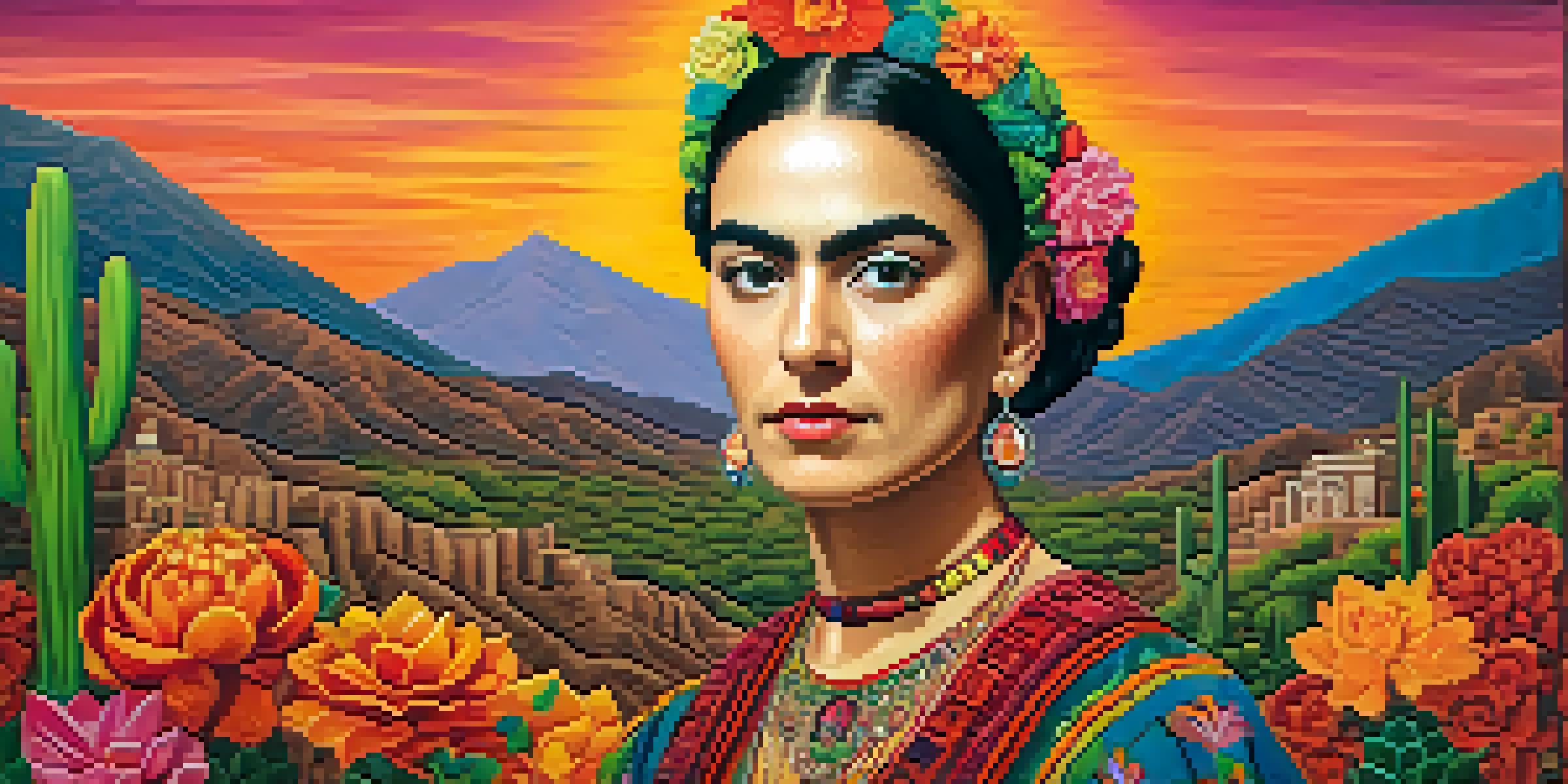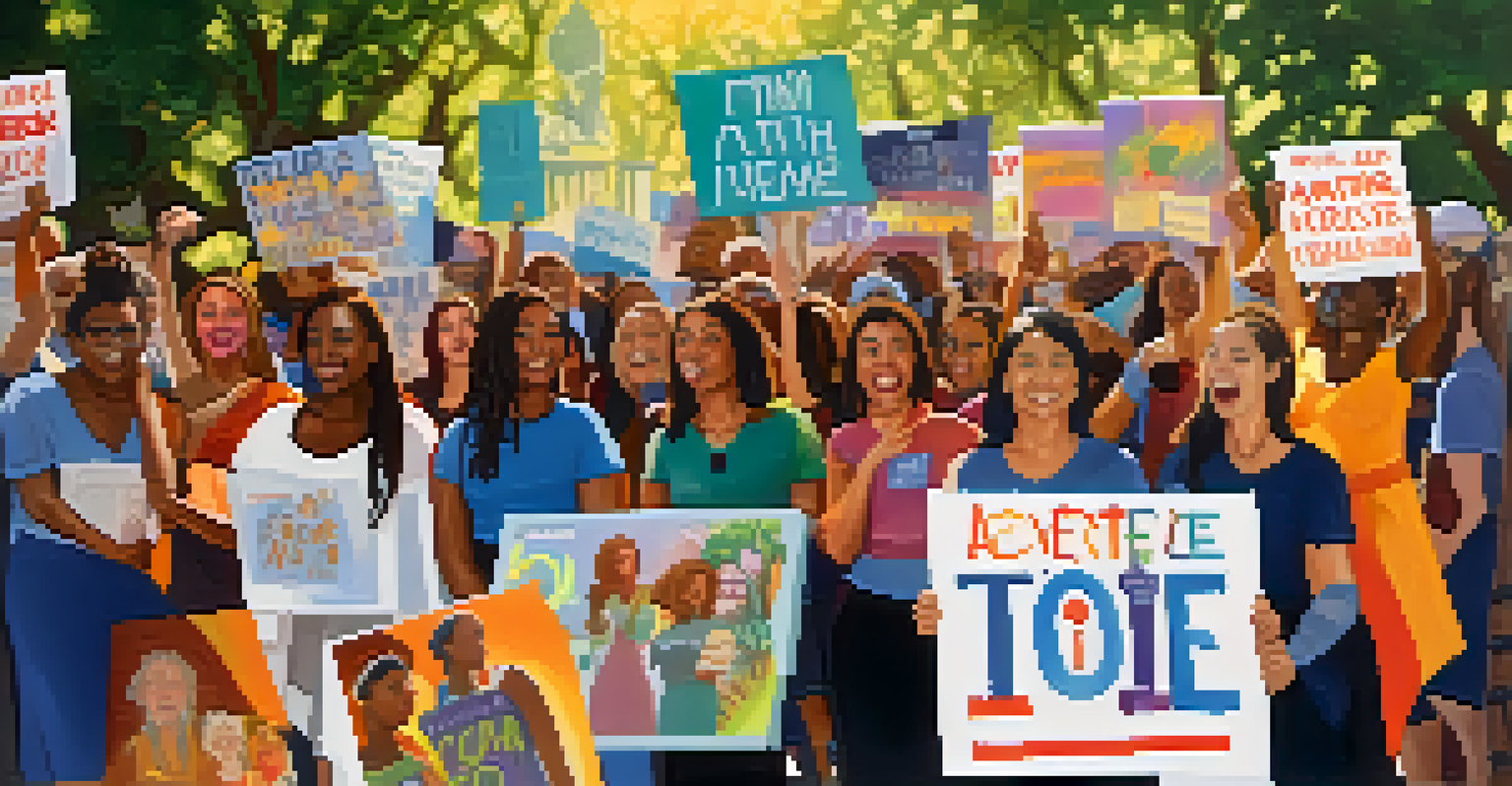Women Artists and Their Impact on Political Art Movements

The Historical Context of Women in Political Art
Throughout history, women artists have often been sidelined in the narrative of political art. Despite this, many have used their creativity to challenge societal norms and advocate for change. In movements spanning from the suffragette era to contemporary activism, women have played pivotal roles, often fueling the fire for social justice through their art.
Art is a way of expressing human emotions, and women have always been at the forefront of that expression.
For example, during the suffrage movement, artists like Mary Cassatt and Käthe Kollwitz created works that highlighted the struggles of women fighting for their rights. Their art was not just a reflection of their times; it served as a rallying cry, inspiring others to join the cause. This pattern of using art as a tool for political expression continues to resonate today.
Understanding the historical context of these women’s contributions is crucial in recognizing the evolution of political art. Their struggles and triumphs laid the groundwork for future generations of artists, illustrating that art can be a powerful medium for social change.
Iconic Women Artists and Their Political Messages
Several women artists have become icons in the realm of political art, each bringing their unique perspective to the forefront. Take Frida Kahlo, for instance; her vibrant self-portraits often highlighted her pain and identity while subtly critiquing societal issues in Mexico. Kahlo's work has inspired countless movements, making her an enduring symbol of resilience and empowerment.

Another example is Judy Chicago, whose installation 'The Dinner Party' celebrates women's contributions to history. This piece not only honors notable women but also critiques historical narratives that have often excluded female voices. Chicago's approach exemplifies how art can challenge the status quo and provoke conversations around gender and power.
Women Artists Shape Political Art
Throughout history, women artists have used their creativity to challenge societal norms and advocate for change, significantly influencing political art.
These artists remind us that political art isn't always loud or confrontational; it can also be deeply personal and introspective. Through their work, they demonstrate that every brushstroke can carry a message, making political statements accessible to a broader audience.
The Feminist Art Movement and Its Legacy
The Feminist Art Movement of the 1970s marked a turning point for women artists seeking to claim their space in the art world. Artists like Linda Nochlin and Miriam Schapiro challenged the male-dominated art scene by advocating for female representation and addressing issues like gender inequality through their work. This movement not only elevated women's voices but also reshaped the narrative around art itself.
The artist's job is to be a witness to their time in history.
Feminist art took various forms, from performance art to installations, all aimed at highlighting the experiences of women. These artists created a dialogue around how women's experiences were often trivialized in mainstream art, pushing back against traditional norms. Their efforts have inspired subsequent generations to continue this important work.
The legacy of the Feminist Art Movement is evident today, as contemporary artists build on this foundation to address current social issues. By examining the past, we can better understand the ongoing struggle for equality in the art world and beyond, proving that political art remains a vital force for change.
Contemporary Women Artists Influencing Political Discourse
Today, women artists continue to influence political discourse through their innovative approaches and powerful messages. Artists like Ai Weiwei's collaborator, the Afghan artist Shirin Neshat, use their work to address themes of identity, displacement, and the complexities of gender politics. Neshat’s photographs and videos challenge viewers to confront uncomfortable truths about society.
Additionally, artists like Hank Willis Thomas and Theaster Gates often collaborate with women artists to amplify their messages. This collaborative spirit fosters an environment where diverse voices can come together to address pressing issues like racism, inequality, and environmental justice. It highlights how art can serve as a bridge between different communities.
Feminist Art Movement's Impact
The Feminist Art Movement of the 1970s transformed the art world by elevating women's voices and addressing issues like gender inequality.
These contemporary artists are not only creating compelling works but are also engaging with audiences in meaningful ways. By using social media and public installations, they expand the reach of their political messages, making art a catalyst for dialogue and action.
Art as a Form of Protest: Case Studies
Art has long been a powerful tool for protest, and women artists have been at the forefront of this movement. Take the Women’s March in 2017, where artists like Jennifer Lopez and Amanda Phingbodhipakkiya used their talents to create impactful visual statements advocating for women’s rights. Their art not only captured the spirit of the march but also spread the message to a global audience.
Similarly, the work of the Guerrilla Girls, an anonymous group of feminist artists, highlights the gender disparity in the art world. They use provocative posters and billboards to expose inequalities and challenge institutions, making their art a form of activism. This approach demonstrates how art can be both a creative expression and a powerful statement against injustice.
These case studies show that art can mobilize communities and bring attention to critical issues. Whether through large-scale protests or intimate exhibitions, women artists continue to demonstrate that their work can inspire change and foster solidarity.
The Role of Social Media in Women's Political Art
In today's digital age, social media plays a crucial role in amplifying the voices of women artists engaged in political discourse. Platforms like Instagram and Twitter allow artists to share their work widely, reaching audiences that traditional galleries might not. This democratization of art means that marginalized voices can be heard and celebrated.
Artists like Amanda Gorman, known for her powerful spoken word poetry, have leveraged social media to share their messages with millions. Her poem at the Biden inauguration became a cultural phenomenon, showcasing the potential for art to influence political conversations. This kind of visibility empowers artists to take center stage in societal discussions.
Social Media Amplifies Women's Voices
In today's digital age, social media empowers women artists to share their political messages widely, fostering community and collaboration.
Moreover, social media fosters community and collaboration among artists. It enables them to connect with one another, share resources, and support each other's initiatives. In this sense, social media is not just a platform but a vital space for nurturing political art movements led by women.
The Future of Women Artists in Political Art Movements
As we look to the future, the role of women artists in political art movements remains crucial. With the ongoing struggles for equality, climate justice, and social reform, their voices are needed more than ever. Emerging artists are stepping up, using their talents to address contemporary issues with fresh perspectives and innovative techniques.
Institutions are also beginning to recognize the importance of showcasing women artists, which can lead to greater representation and support in the art world. This shift opens doors for younger artists and allows for a more diverse array of narratives to be told through art. It signals a positive change in how society values women's contributions.

Ultimately, the future of political art will be shaped by the creativity and resilience of women artists. As they continue to challenge norms and inspire action, they will undoubtedly leave an indelible mark on the world of art and beyond.